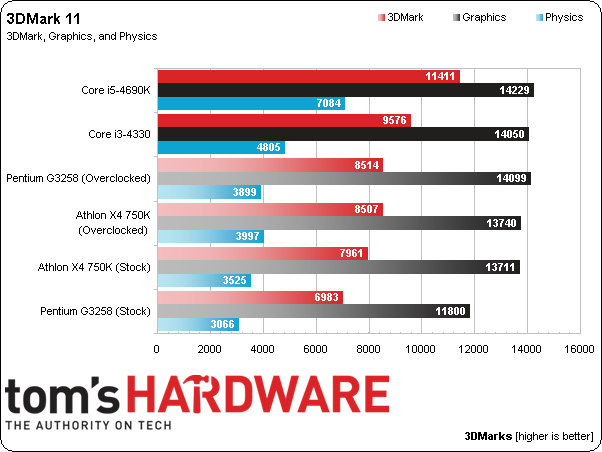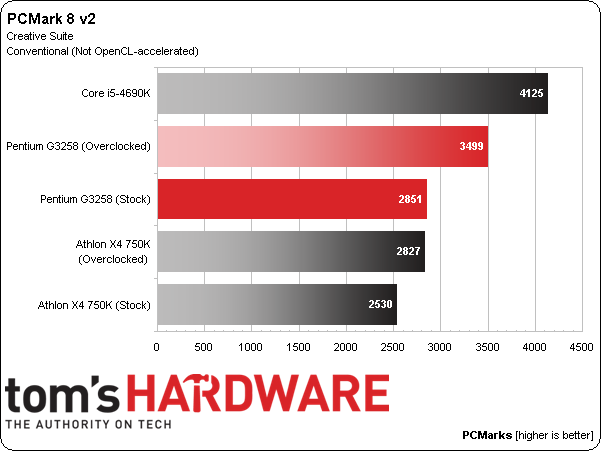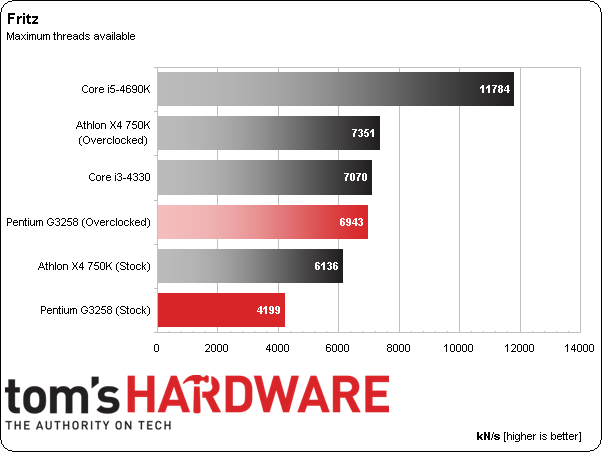Intel Pentium G3258 CPU Review: Haswell, Unlocked, For $75
It's a momentous occasion. Intel now offers an affordable dual-core Pentium with an unlocked multiplier based on its Haswell architecture. How well does it overclock? Can it beat AMD's potent little Athlon X4 750K? We run both through our benchmark suite.
Results: Synthetics
With that small library of games benchmarked, I’m not sure there’s much more we could learn from a synthetic. However, there actually is some useful information to digest.
First, let’s look at the Graphics score. Typically, you’d expect this to be even from top to bottom, as Futuremark effectively shifts as much processing to the GPU as possible. And yet, while the Core i5, i3, and overclocked Pentium demonstrate fairly similar scores, the Athlon is a bit slower, and the stock Pentium G3258 downright hobbles a GeForce GTX Titan. Don’t be bothered by this; nobody’s going to pair a $75 CPU and $1000 graphics card. Still, even in a synthetic, it’s impossible to overcome that gross imbalance.
Shift focus over to the Physics suite, intended to isolate CPU performance. Futuremark reflects the superiority of four physical cores in a threading-optimized game by giving Intel’s Core i5 a big advantage. The Core i3 is a dual-core chip; however, it employs Hyper-Threading to schedule four threads, and so it claims a second-place finish. AMD employs a dual-module design with four integer units and a lot of shared resources. At a stock 3.4 GHz, it finishes second-to-last. But overclocking to 4.3 GHz yields third place. The dual-core, no-frills Pentium gets hammered in stock form, and picks up a spot once it’s overclocked.
The overall score blends the outcomes. Except for the Core i5 and i3, those red bars don’t really do a good job forecasting real-world performance. However, we like to think of synthetics as better gauges of a future where everything is maximally optimized, and that’d take more emphasis on multi-core CPUs in games.
We enter the realm of performance on the desktop outside of gaming with a PCMark chart. The Core i3 is missing because it repeatedly failed this benchmark.
Stock, Intel’s Pentium G3258 roughly ties the overclocked Athlon, while tuning takes the Pentium up several notches. It remains to be seen if these numbers translate over to our benchmark suite.
The Fritz chess benchmark puts a pointed emphasis on threading, specifically reflecting the integer performance of these CPUs. As a result, Intel’s Haswell-based Core i5-4690K dominates. It’s followed by AMD’s overclocked Athlon X4 750K, which puts its four integer units to good use. The Core i3 places third. Although it only wields two cores, Hyper-Threading helps keep them fully utilized—so much so, in fact, that a dual-core Pentium G3258 overclocked to 4.5 GHz can’t quite keep up.
Get Tom's Hardware's best news and in-depth reviews, straight to your inbox.
Current page: Results: Synthetics
Prev Page Results: World of Warcraft Next Page Results: Content Creation-
Heironious Article title says its $75, the picture used says its $3 more than the i3. 75 and it's a deal otherwise no point in paying 3 bucks more for it rather than the i3.Reply -
envy14tpe It's always great seeing the full potential of technology but I'd rather see the Pentium on a mobo somebody would really buy and see how overclocking on a budget would be...more realistic.Reply -
silverblue AMD really needs a new model featuring Steamroller cores and a disabled GPU, say, a 770K. It wouldn't change the gaming scores all that much, but various benchmarks would definitely improve. As it is, the G3258 is a nice processor, but it won't go for that $75 to begin with.Reply -
Smallfilou What if "the fool" who bought that Pentium G and Z97 did so expecting to swap the processor in one year or two for a broadwell, once he got the cash? That would make him a very wise fool indeed... I'd say!Reply
Because of course buying a pentium G and fitting it with a 150USD board and 50USD cooler does not make sens by itself ,but you have a 100% future-compatible system that can be upgraded very very easily... -
knowom Could get a Q9550 for that price on Ebay nice try Intel, but that would kick the crap out of that weak Pentium it's reasonably on par with the i5. Way too damn expensive for what it is in reality.Reply -
BoredErica Hyperthreading is typically considered to be bad for Chess. It increases inefficiencies in search and although you get a larger kilonodes per second which looks nice as a benchmark score, you are actually lowering the strength of the engine. So when I look at Fritz benchmarks on PC sites I take them with a grain of salt.Reply -
lunyone I'd probably look at something like this for this kind of CPU:Reply
PCPartPicker part list / Price breakdown by merchant
CPU: Intel Pentium G3258 3.2GHz Dual-Core Processor ($74.99 @ Newegg)
CPU Cooler: Cooler Master Hyper 212 EVO 82.9 CFM Sleeve Bearing CPU Cooler ($30.99 @ Amazon)
Motherboard: ASRock Z87 Pro3 ATX LGA1150 Motherboard ($90.00 @ Newegg)
Memory: G.Skill Ares Series 8GB (2 x 4GB) DDR3-1600 Memory ($75.99 @ Newegg)
Storage: Seagate Barracuda 1TB 3.5" 7200RPM Internal Hard Drive ($52.92 @ Amazon)
Video Card: XFX Radeon R9 280 3GB Double Dissipation Video Card ($209.99 @ Newegg)
Case: Corsair 200R ATX Mid Tower Case ($49.99 @ Newegg)
Power Supply: XFX 550W 80+ Bronze Certified ATX Power Supply ($44.99 @ NCIX US)
Total: $629.86
Prices include shipping, taxes, and discounts when availableGenerated by PCPartPicker 2014-06-17 04:48 EDT-0400 -
Smallfilou Reply13521069 said:Could get a Q9550 for that price on Ebay nice try Intel, but that would kick the crap out of that weak Pentium it's reasonably on par with the i5. Way too damn expensive for what it is in reality.
No, sorry. That is not true. Check this article:
http://www.tomshardware.com/reviews/ivy-bridge-wolfdale-yorkfield-comparison,3487-10.html
You should overclock your Q9550 to get performance that barely comes close to an ivy-bridge I3 on games and lightly threaded workloads (and it gets stomped by any i5 on any workload)... I personally have an OC'd QX9650 and am not even close. I believe if I change to that Pentium G, and overclock it as well, that would still be an upgrade... -
Memnarchon Reply13520870 said:Having looked, the fool would build a cheap pc with that chip and a z97 board, and the wise man would use the i3 and an h81 board. Similar priced systems..
Yeah that would be better unless Intel decides to let o/c on Pentium with other chipsets like H97.
Leaked BIOS Enables Pentium Anniversary Edition OC on Some MSI H97 Boards
MSI H97 PC MATE ATX LGA1150 Motherboard $88.99
So if this happens and intel decide to let even lower mobo chipsets to do o/c only for pentiums it would be nice to pair $60 mobo, $75 CPU and a $25-30 CM 212 EVO or plus, to a total of ~$160 for a o/c ready system.



